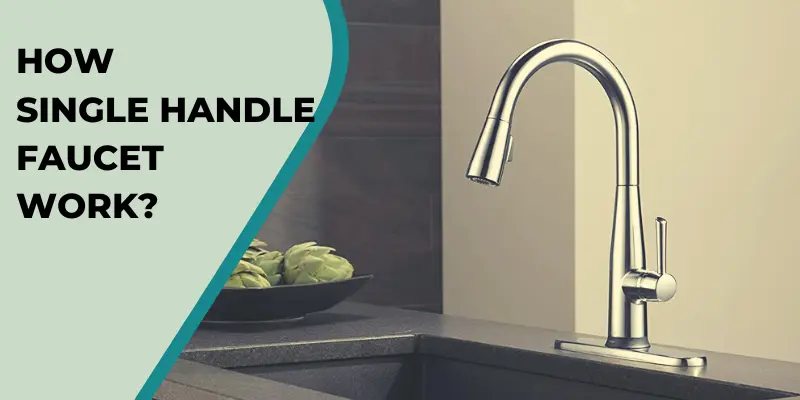A single-handle faucet is a common fixture you will find in many kitchens or bathrooms. Controlling water flow and adjusting the water temperature becomes very easy with its single-handle design. For a limited space, its design is a great space saver.
Ever you think how does a single handle faucet work? What is the mechanism behind its functioning? The main question is do you need to understand its functioning? It is not compulsory but if you have knowledge of single-handle faucet functioning, you can decide which faucet is right for you and also it becomes easy to troubleshoot the faucet.
Single Handle Faucet
As its name clears, it has a handle to control both water flow and temperature. Single handle faucet is a common type that is available for every brand. Also, it can be used in the kitchen or bathroom. For a modern interior, it is a good choice.
It is convenient to use due to its precise control of the handle. If your one hand is dirty, you can use a second hand to use the faucet.
A single handle faucet comes with various features such as pull out or down spray, high arc spouts, sensors, voice commands, and different spray modes. Its high arc spout gives more convenience to filling pots and washing dishes. There are different finishes for the single handle tap. You should choose the right finish that complements the color palate of the kitchen. Its performance is superb.
Parts of a Single Handle Faucet
Handle
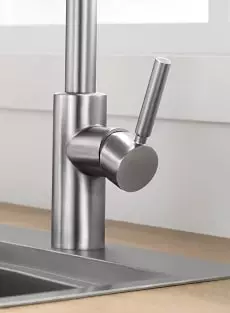
The handle is an important part of the single-handle faucet. It allows you to control the water flow and temperature. In some models, it is located at the top of the faucet (in pull-out models), and in some, it is situated at the side (in a pull-down or high arc models).
In most models, it is designed in the lever shape. This design is easy to operate. You also get knob or cross-lever options for the handle. Its small design needs less space for installation.
Spout
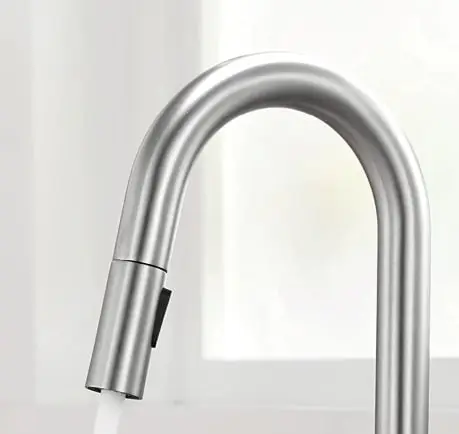
Spout is also called the spray head. It is the front part of the faucet from where water comes out. The spout can be fixed or pulled. Most people prefer a spout that can be pulled outside because it provides good flexibility in the sink. Prefer a spout that is made of metal instead of plastic material. It is pulled every time when we wash dishes, so it should be durable and convenient to hold.
Aerator
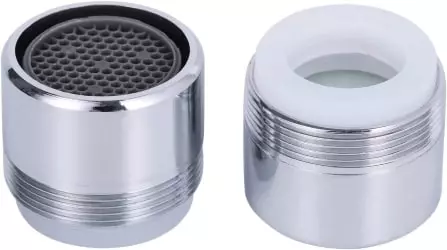
Aerator is a small mesh screen that is found inside the spout. It is placed at the end of the spout. Its work is to provide a smooth water screen without splashing water everywhere. It helps to save water by reducing the use of water.
It comes to be default with the faucet but if you want, you can remove it. With time, it may become clogged due to water sediments. You should clean it regularly to prevent buildup on it.
Cartridge
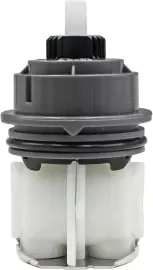
The cartridge is an internal part of the fixture. It is used to control the water flow. You will find it inside the handle.
When you turn the handle, the cartridge changes its direction and water flows through it. It is made of plastic so with time it gets damaged and after a certain point, you need to change it. If you don’t change a damaged cartridge, you will see the leak or drip from the handle.
O-rings
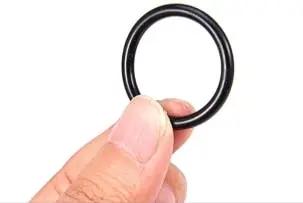
O-rings are also an important part of the faucet. It is used in many places of the faucet. It creates a watertight seal and prevents leaks from the different connections of the faucet. O-rings are worn-out with time. You can replace it by removing the handle or spout.
Escutcheon Plate
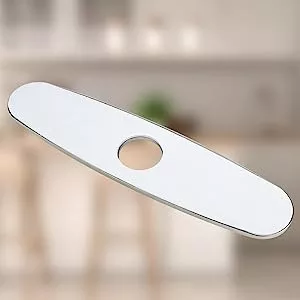
The Escutcheon plate is not an essential part of the single-handle faucet but it comes with most faucets.
An Escutcheon plate is needed if you are installing a single-handle faucet into a three holes sink. It covers the extra holes in the sink and provides a polished look to the sink and faucet. It comes in either a rectangular or circular shape.
Related Post – How Does 2 Handle Faucet Work?
How Does a Single Handle Faucet Work?
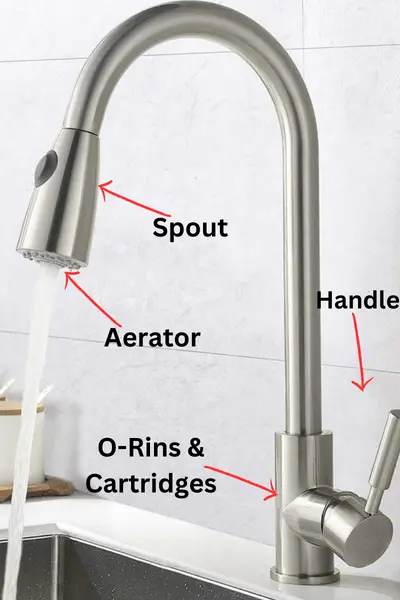
- To operate the single handle faucet, you need to turn its handle. When you turn the handle, the handle lifts the cartridge or ball valve inside the faucet.
- The change in the position of the cartridge or ball valve either turns on the water flow or stops the water flow. The flow of water depends on the position of the cartridge or ball valve.
- Now water flows into the faucet and comes to the spout.
- At the spout, first, it passes through the aerator and then comes out.
- Also, at the spout, you can change the way of outcoming water. When you press the spray button, water flow changes into stream or spray mode.
- To change the water flow, move the handle in the front or back direction. When you move it front, it increases the water flow and to decrease flow, move it to the back.
- When you turn the handle in the right and left direction, you can change the temperature of the water.
A mixing valve is an important part of the faucet. It controls the temperature of the water. Mixing valve adjusts the ratio of hot and cold water. It is connected to the cartridge of the faucet and moves with the cartridge.
Comparison Between Single and Double Handle Faucet
| Feature | Single Handle Faucet | Double Handle Faucet |
|---|---|---|
| Flow Control | One handle controls both flow rate and temperature | Two handles control flow rate separately for hot and cold water |
| Space Required | Takes up less space on the sink | Takes up more space on the sink |
| Installation | Typically easier to install and maintain | Can be more complex to install and maintain |
| Design Options | Wide variety of design options available | Fewer design options available |
| Price | Generally less expensive | Can be more expensive |
| Water Conservation | May offer better water conservation features, such as aerators or low-flow options | May not offer as many water conservation features |
| Durability | Cartridges and valves may wear out more quickly | Separate valves and handles may provide longer lifespan |
| Temperature Control | Can be more difficult to achieve precise temperature control | Offers more precise control over hot and cold water flow |
| User-Friendliness | Easy to use with one hand | Requires both hands to adjust temperature and flow rate |
| Maintenance | May require less frequent maintenance | May require more frequent maintenance due to more complex mechanisms |
Tips For Long Life of Single Handle Faucet
Clean Faucet Regularly
Regular cleaning of the faucet is essential. If you don’t clean it, dirt, buildup, and grime will form on it. Also, its finish won’t look as new longer. Water spots and fingerprints will make the finish dull and unsightly.
When you clean it regularly or at the end of every day, its life increases and it looks new for longer and also works well without any issues.
Use Only Soft and Clean Water
Water quality also affects the life of a single handle tap. Hard water contains minerals that create buildup outside and inside the faucet. With time, the thickness of the buildup increase which affect the flow of water and eventually stop it.
Buildup also damages the internal parts of the faucet. When you use a water softener, it removes minerals from the water. If you see white spots near the spout, it means your water quality is not good and you should make it soft. It would be a good idea to install a common water softener in the house to clean water for all faucets.
Replace Faulty Parts
Single handle fixture is like a machine. When its different parts move, it initiates or stops the water flow. Like other machines, its parts also become faulty or damaged.
When there is a damaged part inside the faucet, it will cause a leak, water pressure issue, wrong temperature, or any other issue. It is not a small thing and you should not ignore it. If you ignore replacing a faulty part, with time it will damage other parts of the faucet. So, you should replace a faulty or damaged part as soon as you notice it.
Related Post

James Lewis is a seasoned plumber and faucet enthusiast who shares his expertise on Faucetsavvy.com. With over 15 years of experience in the plumbing industry, he’s passionate about helping homeowners find the perfect faucet for their needs. He’s also dedicated to empowering DIY enthusiasts with the plumbing knowledge and skills needed to repair and maintain their faucets.
Recommended By Faucetsavvy's Team
Best Kitchen Faucets of 2025: Sleek, Durable & Worth Every Penny Check Our Review

